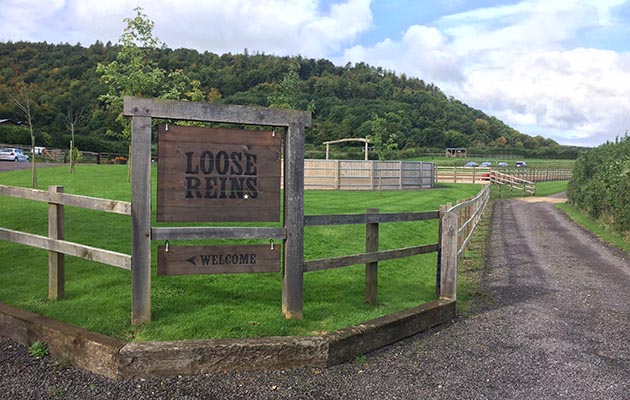Western riding is about much more than just using a different saddle, and it’s a discipline in its own right. Historically, it’s a softer form of dressage. The horse, once extinct in America, was reintroduced in the 15th and 16th Century as a cavalry charger, beautifully trained to the rider’s weight shifts and leg aids. The Spanish conquistadors who invaded later wanted a sophisticated horse to work the cattle they’d brought to the new world, but who would work a very much softer outline in order not to spook the herds.
Saddles were built to be as comfortable as possible to allow for long work hours, and horses were trained to make them quick and responsible, lessening rider fatigue.
Now, riders across the UK are discovering that the more laid-back style of Western suits them and their horse — but there’s a lot more to it than just throwing on a saddle and riding off into the sunset.
International Western riding instructor and author Bob Mayhew (pictured top, executing a sliding stop with his stallion, First Draw Peppy) was introduced to the discipline in 1978, and by 1983 had bought the Avenue Riding Centre with the idea of starting to offer Western riding.
“One of the biggest problems at the time was the public perception that the discipline was about rodeos and not the sophisticated quality of training that the true Western horse exhibited. So my crusade to rectify that started!” he says. “I started the Western Equestrian Society (WES) with Roger Wells, a lifelong friend, to cater for those interested in quality western riding, and today, it’s the largest UK society for the discipline. As with English riding, there are many sub-divisions including pleasure, trail, reining, ranch horse, and western riding.
“What appealed to me about Western riding was the calmness, smoothness, and obedience of the Western horse. A team, a partnership of horse and rider working together while seemingly staying away from the reins. Looking back, it’s funny to think of the struggles we had to get Western accepted — these have pretty much disappeared when we see so many English riders flocking to natural horsemanship clinics now to learn Western-style ideas.”
“All horses can be trained to go Western to some level. You may not win competition prizes, but you’ll have fun.”
Jim Lyner, a WES committee member, has been involved with the discipline for over 20 years. He agrees that Western a very accessible form of riding.
“At WES, we promote the sport for enthusiasts at all levels, whether pure beginners or seasoned competitors. You can enjoy all of our ridden activities with ANY breed of horse or pony — we have members with Highland ponies, Welsh ponies and cobs, traditional cobs, Haflingers, Arabians and also the various Western breeds. Nearly every horse that has a Western saddle put on its back seems to enjoy it.”
According to Bob, kitting your horse out in Western tack is a ‘how long is a piece of string’ question — there are Western saddles and bridles to suit all pockets.
“You should be paying a little more than the equivalent in English tack, but I would always say invest in correct fitting and quality to the top of your budget and it will pay dividends in the end,” he says. “Your English hard hat is more than acceptable in riding Western, as Stetsons are only for riding trained horses in competitions.”
Jim agrees: “The saddle is the major investment, and, contrary to popular belief, not all Western saddles fit every horse. It’s much better to spend your money on a good quality second hand saddle than a cheaply made new one, and you do need to have it properly fitted by a Western saddle fitter. The main difference between Western and English saddles is that the English saddle is supported by the spinal muscle of the horse and is adapted to the individual discipline, while a Western saddle is supported by the horse’s ribcage, which helps to spread the load of the saddle and the rider more evenly across the back.
If you’d like to have a go at Western riding, then start by taking a look at the WES website.
“WES is divided up into 13 regional areas each with its own shows, clinics and members’ days,” says Jim. “Clinics are open to non-members and can be ridden in English tack, so you can try the experience. All details can be found on the website or on the areas’ individual Facebook pages, and everyone is welcome to come and watch!”
For all the latest news analysis, competition reports, interviews, features and much more, don’t miss Horse & Hound magazine, on sale every Thursday.
You might also be interested in:

Try something new in 2019 — polocrosse
Find out how you can get involved with this exciting, fast-paced game

Fancy trying your hand at horse agility? Here’s what you need to know first…

Subscribe to Horse & Hound magazine today – and enjoy unlimited website access all year round




